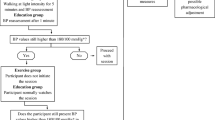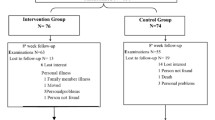Abstract
Background
The increasing prevalence of functionally-limited hypertensive individuals highlights the need for interventions to reduce the burden of hypertension-aging-disability and to maximize the chances of healthy aging.
Aim
This study aims to compare the effects of multicomponent exercise and different pharmacological treatments on functional status and cardiovascular risk outcomes in hypertensive older adults with comorbidities.
Methods
Participants (n = 96) engage in a 3 days/week multicomponent (aerobic + resistance) exercise program and for one of the following three conditions: (1) thiazide-related diuretics (TDs; n = 33, 69.9 ± 9.5 years); (2) calcium channel blockers (CCBs; n = 23, 67.0 ± 9.0 years); (3) and β-blockers (βBs; n = 40, 65.6 ± 7.2 years) medication. Baseline and 2-year follow-up evaluations included the Senior Fitness Test battery, anthropometrics and hemodynamic profile, health-related quality of life (HRQoL; Short-Form Health Survey 36) and health history questionnaires.
Results
All groups have significantly improved the physical functional status; particularly upper and lower body strength and aerobic endurance and systolic blood pressure. The TDs and βBs groups have diminished the waist circumference and body mass. The CCBs decreased total cholesterol (P = 0.028), perceived better physical functioning, physical component score but also augmented bodily pain (P < 0.05). The βB group decreased triglycerides (P = 0.013). No group differences were found.
Conclusion
Multicomponent exercise training has improved functional status regardless of the antihypertensive medication options. Hypertensive older adults should add exercise training to pharmacological antihypertensive therapy to reduce the rate of physical disability.


Similar content being viewed by others
References
Mancia G, Fagard R, Narkiewicz K et al (2013) 2013 ESH/ESC guidelines for the management of arterial hypertension: The Task Force for the management of arterial hypertension of the European Society of Hypertension (ESH) and of the European Society of Cardiology (ESC). Eur Heart J 34:2159–219
Buford TW (2016) Hypertension and aging. Ageing Res Rev 26:96–111
Hajjar I, Wharton W, Mack WJ et al (2016) Racial disparity in cognitive and functional disability in hypertension and all-cause mortality. Am J Hypertens 29:185–193
Sumukadas D, Band M, Miller S et al (2014) Do ACE inhibitors improve the response to exercise training in functionally impaired older adults? A randomized controlled trial. J Gerontol A Biol Sci Med Sci 69:736–743
Berlowitz DR, Breaux-Shropshire T, Foy CG et al (2016) Hypertension treatment and concern about falling: baseline data from the systolic blood pressure intervention trial. J Am Geriatr Soc 64:2302–2306
Dumurgier J, Elbaz A, Ducimetière P et al (2009) Slow walking speed and cardiovascular death in well functioning older adults: prospective cohort study. BMJ 339:b4460
Dumurgier J, Elbaz A, Dufouil C et al (2010) Hypertension and lower walking speed in the elderly: the three-city study. J Hypertens 28:1506–1514
Carter CS, Marzetti E, Leeuwenburgh C et al (2012) Usefulness of preclinical models for assessing the efficacy of late-life interventions for sarcopenia. J Gerontol Ser A Biol Sci Med Sci 67:17–27
Buford TW, Manini TM, Hsu F-C et al (2012) Angiotensin-converting enzyme inhibitor use by older adults is associated with greater functional responses to exercise. J Am Geriatr Soc 60:1244–1252
Rosenberg PB, Mielke MM, Tschanz J et al (2008) Effects of cardiovascular medications on rate of functional decline in Alzheimer disease. Am J Geriatr Psychiatry 16:883–892
Shih HM, Lin WC, Wang CH et al (2014) Hypertensive patients using thiazide diuretics as primary stroke prevention make better functional outcome after ischemic stroke. J Stroke Cerebrovasc Dis 23:2414–2418
Sica D (2011) Are there pleiotropic effects of antihypertensive medications or is it all about the blood pressure in the patient with diabetes and hypertension? J Clin Hypertens 13:301–304
Cesari M, Pedone C, Antonelli Incalzi R et al (2010) ACE-Inhibition and physical function: results from the trial of angiotensin-converting enzyme inhibition and novel cardiovascular risk factors (TRAIN) study. J Am Med Dir Assoc 11:26–32
Zhubrina ES, Ovchinnikov AG, Seredenina EM et al (2009) Optimization of use of beta-adrenoblockers in the treatment of chronic heart failure in the outpatient setting. Ter Arkh 81:35–40
Belenkov IN, Skvortsov AA, Mareev VI et al (2003) Clinical, hemodynamic and neurohumoral effects of long-term therapy of patients with severe chronic heart failure with beta-adrenoblocker bisoprolol. Kardiologiia 43:10
Kritchevsky SB, Nicklas BJ, Simonsick EM et al (2005) Angiotensin-converting enzyme insertion/deletion genotype, exercise, and physical decline. JAMA 294:691-698
Liu CK, Leng X, Hsu FC et al (2014) The impact of sarcopenia on a physical activity intervention: The lifestyle interventions and independence for elders pilot study (LIFE-P) study. J Nutr Heal Aging 18:59–64
Pahor M, Blair SN, Espeland M et al (2006) Effects of a physical activity intervention on measures of physical performance: results of the lifestyle interventions and independence for elders pilot (LIFE-P) study. J Gerontol A Biol Sci Med Sci 61:1157–1165
Baptista LC, Machado-Rodrigues AM, Verissimo MT et al (2017) Exercise training improves functional status in hypertensive older adults under angiotensin converting enzymes inhibitors medication. Exp Gerontol. https://doi.org/10.1016/j.exger.2017.06.013
World Health Organisation (2013) Declaration of Helsinki world medical association declaration of Helsinki ethical principles for medical research involving human subjects. J Am Med Assoc 310:2191
American College of Sports Medicine (2010) ACSM’S guidelines for exercise testing and prescription, 8th edn. Lippincott Williams & Wilkins, Philadelphia
Rikli RE, Jones CJ (2013) Development and validation of criterion-referenced clinically relevant fitness standards for maintaining physical independence in later years. Gerontologist 53:255–267
Borg G (1988) Perceived exertion and pain scales. Human Kinetics, Champaign
Rikli RE, Jones CJ (1999) Development and validation of a functional fitness test for community-residing older adults. J Aging Phys Act 7:129
Ferreira PL (1998) A Medição do Estado de Saúde: Criação da Versão Portuguesa do MOS SF-36. Cent Estud E Investig Em Saúde Da Univ Coimbra
Anderson C, Laubscher S, Burns R (1996) Validation of the short form 36 (SF-36) health survey questionnaire among stroke patients. Stroke 27:1812–1816
Ware JE Jr (2000) SF-36 health survey update. Spine (Phila Pa 1976) 25:3130–3139
Hedges LV, Olkin I (1985) Statistical methods for meta-analysis. Academic Press, New York
Cohen J (1988) Statistical power analysis for the behavioural sciences. Academic Press, New York
Digne-Malcolm H, Frise MC, Dorrington KL (2016) How do antihypertensive drugs work? insights from studies of the renal regulation of arterial blood pressure. Front Physiol 7:320. https://doi.org/10.3389/fphys.2016.00320
Weber MA (2005) The role of the new beta-blockers in treating cardiovascular disease. Am J Hypertens 18:169S–176S
Simon CB, Lee-McMullen B, Phelan D et al (2015) The renin-angiotensin system and prevention of age-related functional decline: where are we now? Age (Dordrecht) 37:9753. https://doi.org/10.1007/s11357-015-9753-5
Carter JB, Banister EW, Blaber AP (2003) Effect of endurance exercise on autonomic control of heart rate. Sports Med 33:33–46
Lambert GW, Jonsdottir IH, Gavin W et al (1998) Influence of voluntary exercise on hypothalamic norepinephrine. J Appl Physiol 85:962–966
Soares-Miranda L, Sattelmair J, Chaves P et al (2014) Physical activity and heart rate variability in older adults: the cardiovascular health study. Circulation 129:2100–2110
Azizi M, Pereira H, Hamdidouche I et al (2016) Adherence to antihypertensive treatment and the blood pressure–lowering effects of renal denervation in the renal denervation for hypertension (DENERHTN) trial. Circulation 134:847–857
Kurklinsky AK, Levy M (2013) Effect of ramipril on walking times and quality of life among patients with peripheral artery disease and intermittent claudication: a randomized controlled trial. J Am Med Assoc 309:453
Sumukadas D, Witham MD, Struthers AD et al (2007) Effect of perindopril on physical function in elderly people with functional impairment: a randomized controlled trial. CMAJ 177:867–874
Ambrose KR, Golightly YM (2015) Physical exercise as non-pharmacological treatment of chronic pain: why and when. Best Pract Res Clin Rheumatol 29:120–130
Acknowledgements
The authors are grateful to all medical interns of Santa Maria da Feira for their technical support, especially to Doctor Nunes Sousa and Macedo Coelho; to Santa Maria da Feira Council with a special greeting to Social Division, to Dra. Manuela Coelho and Francisco Rocha for the disposable and availability to the study prosecution in the community exercise program “Movimento e bem-estar”; to all physical education professionals in the exercise program, and finally, we also thank to all participants who gave literally their physical and mental contributions.
Funding
This study was funded by a Portuguese grant from Portuguese Science and Technology Foundation (SFRH/BD/90221/2012).
Author information
Authors and Affiliations
Corresponding author
Ethics declarations
Conflict of interest
No potential conflicts of interest relevant to this article are declared.
Ethical approval
All procedures performed in this study were in accordance with the ethical standards of the institutional and national research committee and with the 1964 Helsinki declaration and its later amendments.
Informed consent
Informed consent was obtained from all individual participants included in the study.
Rights and permissions
About this article
Cite this article
Baptista, L.C., Amorim, A.P., Valente-dos-Santos, J. et al. Functional status improves in hypertensive older adults: the long-term effects of antihypertensive therapy combined with multicomponent exercise intervention. Aging Clin Exp Res 30, 1483–1495 (2018). https://doi.org/10.1007/s40520-018-0925-x
Received:
Accepted:
Published:
Issue Date:
DOI: https://doi.org/10.1007/s40520-018-0925-x




